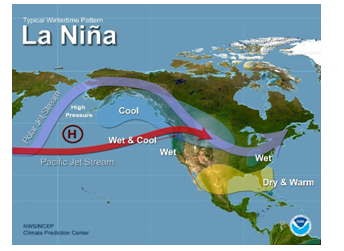

29th August 2024 (11 Topics)
Context
The North Atlantic Ocean has been experiencing record-high surface temperatures, a symptom of broader climatic upheavals. Yet, recent signs of cooling in both the Atlantic and Pacific Oceans may offer a glimmer of hope for vulnerable ecosystems and hurricane-prone regions. This cooling phenomenon, driven by two distinct climate patterns—La Nina and the Atlantic Nina—has the potential to impact weather patterns and hurricane activity significantly. As of August 2024, both patterns appear to be in development, a rare occurrence with complex implications.
What is La Nina?
- La Nina is part of the El Nino–Southern Oscillation (ENSO), a critical climate phenomenon with global repercussions.
- How it occurs?
- It occurs when sea surface temperatures in the tropical Pacific Ocean fall below average.
- This cooling effect strengthens easterly trade winds, leading to increased upwelling of cooler waters along the coast of South America.
- These changes in ocean temperature and wind patterns can influence global weather, often resulting in stormier conditions in some regions and drier conditions in others.
- Crucially, during La Nina events, wind shear in the Atlantic—an important factor in hurricane formation—tends to weaken, allowing hurricanes to develop more easily.
Atlantic Nina
- In contrast, the Atlantic Nina occurs in the Atlantic Ocean and is a much smaller-scale phenomenon compared to its Pacific counterpart.
- It generally peaks around July or August and has a shorter duration.
- Atlantic Ninas typically have localized impacts, such as reduced rainfall in Africa’s Sahel region and increased rainfall in parts of Brazil and the Gulf of Guinea.
- Despite its relatively modest effects, an Atlantic Nina can counteract some of La Nina’s influences by weakening the upwelling processes that cool the eastern Pacific, thereby potentially affecting hurricane activity in the Atlantic.
The simultaneous emergence of both Ninas is rare but not unprecedented. This alignment is akin to two pendulums swinging in opposite directions, moving together due to weak coupling.
Fact Box:El Niño-Southern Oscillation (ENSO) Cycle
Major Global Wind Belts: Global winds are large-scale, persistent wind patterns that circulate across the Earth's surface due to the planet's rotation and the uneven heating of its surface by the Sun.
|





